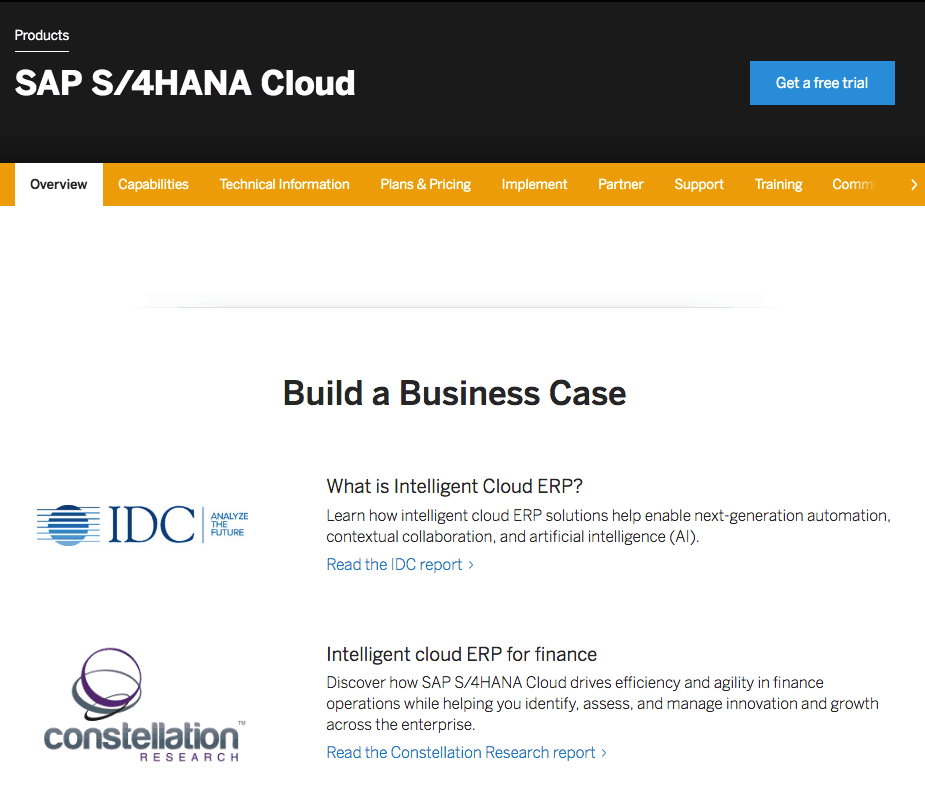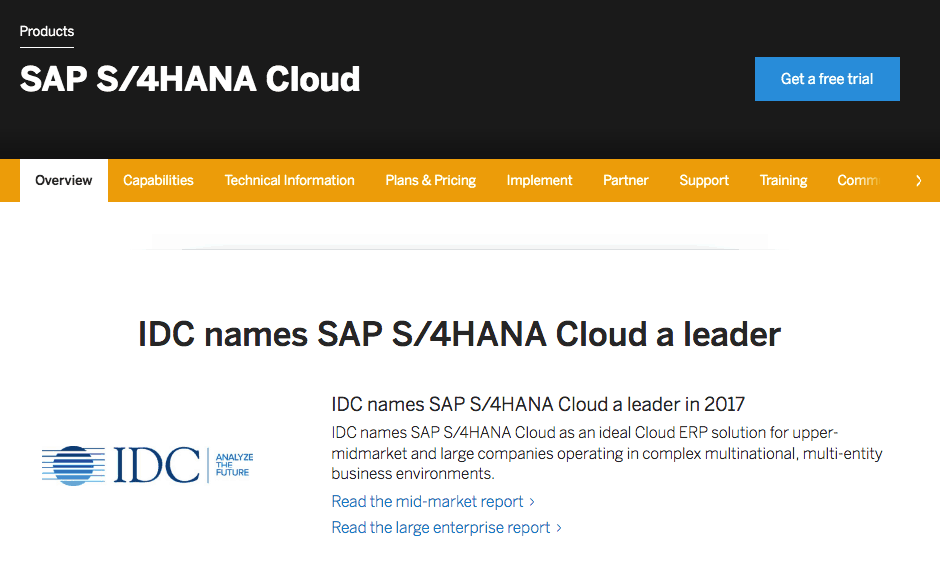The Accuracy of TechTarget’s Article on S/4HANA and Indirect Access
Executive Summary
- TechTarget produced an article with contributors of varying accuracy on S/4HANA and indirect access.
- We analyze the accuracy of each.

Introduction
In this article, we will review the accuracy of TechTarget from its article SAP S/4HANA Cloud and indirect access will dominate 2018.
Something to remember is that TechTarget is not a real journalistic entity. They are a front end for hundreds of vendors and exist to capture email addresses which are then shared with their marketing automation backend.
Questions to IT Analysts on SAP and S/4HANA and AI for 2018
The question asked of various analysts by TechTarget is the following:
“We asked several prominent industry experts for their opinions on what may be in store for SAP in 2018. We were primarily interested in two questions: What do you expect from SAP in 2018, and what does SAP need to do in 2018?”
Answer from Massimo Pezzini Vice President and Fellow, Gartner
“SAP has made significant investments in machine learning over the past two years, which has begun to manifest in the form of add-ons to their established applications (S/4HANA, SuccessFactors, etc.) in the course of 2017. In 2018, the use of AI and [machine learning] technologies will become more pervasive and more widespread (for example, in the context of the user experience layer), thus moving SAP towards the notion of “intelligent enterprise” that Bernd Leukert (head of SAP’s products and innovation) started to depict toward the end of last year.”
Gartner is, as TechTarget, the recipient of income from SAP, which like TechTarget, they do not disclose.
But if we look at this quotation, it reads like a direct quote from SAP’s marketing department. There are not ML add-ons to the S/4HANA or SuccessFactors. SAP is little involved in ML or AI of any kind. Massimo refers to Bernd Leukert, who has been profiled in previous Brightwork articles as providing highly inaccurate information to the market about SAP.
Massimo goes on to say.
“I also expect a further strong commercial and marketing push for cloud ERP, in particular through SAP S/4HANA Cloud and, to a lesser extent, SAP Business ByDesign. Cloud ERP is one of the hottest battlegrounds in the business applications space, where SAP is facing tough competition from Oracle, Workday, Microsoft and other smaller, aggressive competitors. SAP’s chances of maintaining its leadership in ERP depends on how successful it will be in cloud ERP.
SAP needs to focus on making SAP ERP Central Component (ECC) customers’ move to S/4HANA as compelling and easy as possible. Paradoxically, we found that it’s easier for non-SAP ERP organizations to adopt S/4HANA than for ECC users. Most established SAP ERP clients, especially large and global organizations, are finding it difficult to justify the adoption to S/4 from a business case perspective and are concerned by the cost, complexity and time required by the migration project. SAP must work hard to remove these obstacles to make S/4 the success they want and need it to be.
SAP also needs to improve their relationship with clients. Although most SAP clients are reasonably happy with the products and technologies, they often complain because of obscure pricing, confusing product roadmaps and uneven support quality. In 2016, SAP launched the “Empathy to Action” set of initiatives to address such concerns, and in 2017, they released some initial results, such as SAP Transformation Navigator, to provide product roadmap visibility and a couple of new SAP indirect access policies. However, in 2018, SAP needs to show significant progress across the three areas mentioned above to maintain the loyalty of their clients as they engage in digital transformation initiatives.”
Can SAP Make the Move to S/4HANA Compelling and Easy?
SAP cannot make the move of SAP ECC move to “S/4HANA as compelling as easy as possible.” First, there is little reason to move to S/4HANA, and it locks customers into the inferior HANA and high maintenance database. Secondly, there are many factors that make the transition to S/4HANA the most trouble-prone migration in the history of SAP’s primary ERP system. It’s not a “paradox” that S/4HANA is easier for non-previous ECC customers. It’s a natural outcome of the difficulty in migrating from ECC. Massimo is correct that companies have trouble justifying the move to S/4HANA because there is no value to moving to S/4HANA. The functionality is lower than ECC, Fiori is barely used by anyone, and the implementing company gets stuck with HANA. There is not much that SAP can do on any of these fronts. They can make S/4HANA more implementable, so S/4HANA implementations don’t keep failing. (For more on this topic see our article on S/4HANA’s implementation history.)
As for improving relationships with customers, SAP needs to harvest as much out of customers to meet earnings objectives, but they have very few areas of growth in their applications. Therefore, SAP will need to become even more extractive, which will take a toll on customer relationships. We predict customer relationships will get worse, not better.
Answer from Cindy Jutras, President, Mint Jutras LLC
“I think we’ll see an emphasis on cloud and intelligence. In addition, I’d like to see more emphasis placed on delivering last-mile functionality, in addition to more intelligence, but with less of a custom, tools-oriented approach.
I think SAP needs to get some clarity on segmentation of their three different ERP solutions. They have now moved all three under one umbrella, supposedly to reduce contention and confusion. It’s clear that S/4HANA is the right choice for the large enterprise, and Business One is aimed at small businesses. However, there needs to be more clarity on the positioning of Business ByDesign, or the market will continue to make up its own story. And the fabricated story for years now has been that it’s dead. SAP needs to be more vocal about the real intention, because the S/4HANA messaging is adding to the confusion rather than resolving it. More clarity is required around cloud, growth orientation and two-tier ERP for subsidiaries.
In addition, I would like to see the messaging around SAP Leonardo start to be integrated into the ERP story. It can’t be effective and impactful if it continues to be separate because then it will only be a message for the IT staff of large enterprises. For SMBs, the technology itself will need to be blended as well. SMBs, who are a large portion of the SAP installed base, don’t have deep enough pockets or the technical expertise on staff for innovative, design thinking projects that define the value. The Business One platform approach is right on target and could easily be applied upmarket.”
Is It True that S/4HANA is the Right Choice for Large Enterprises
It’s not at all clear that S/4HANA is the right choice for large enterprises, for reasons already given. The positioning of ByDesign is that it was supposed to be sunsetted, but was revived. ByDesign has always been a lousy application and companies that use it dislike it. Overall, ByDesign is not relevant to SAP’s future. But Cindy is correct that ByDesign is cloud and S/4HANA Cloud’s only customers are small, which would put them into the ByDesign target customer, but SAP’s likes to pretend that S/4HANA Cloud can service larger customers also.
SAP has tried to integrate Leonardo into ERP. This is the only way that SAP can make any headway in IoT as they lack a competitive offering. However, the problem is that IoT has nothing to do with ERP. And trying to force fit IoT into ERP will simply increase the costs and reduce the flexibility of any IoT system.
Answer from Josh Greenbaum, Principal, Enterprise Applications Consulting
“There are a lot of gaps to be closed between the forward-looking technology strategy and the reality on the ground for customers, and SAP Leonardo is a good example. The issue of SAP S/4HANA Cloud migration is another. I talked to a customer who was looking at SAP S/4HANA Cloud until they saw how limited the functionality was in a couple of key areas, so they pulled back and are now looking at doing an S/4HANA on-premises or private cloud because they can’t get what they want out of public cloud in the time frame that they need it. Also, a lot of companies are looking at SAP Leonardo functionality and are embracing it for a proof of concept. But we are not seeing a lot of real enterprise cloud deployments, and that’s going to hurt if SAP can’t convert that desire into a lot of serious revenue. And that’s a huge chunk of their strategy.
One of the big issues that SAP has to settle in 2018 and really put to rest is the problem of SAP indirect access licensing. That came up at the end of the year in so many conversations with customers, many of whom were saying that they don’t really trust what’s in their contracts anymore. They don’t know if they can go back to the board for more SAP money considering there’s this potential indirect licensing fiasco looming over them. So, that’s something that SAP should deal with.
It’s a leadership moment for SAP. I think they should also see that this is something that’s endemic to the entire industry, so it’s happening across the board and is not just an SAP issue. SAP could actually turn this into a real leadership moment if they chose to, and I think they should.”
Combining Good Advice on S/4HANA with Bad Advice on Indirect Access
This is also good and realistic advice on S/4HANA. This acknowledges the limited S/4HANA Cloud functionality. Josh Greenbaum answers the question of what SAP needs to do, rather than solely what “we will see from them.”
It would be nice for SAP to shut down indirect access, but how will SAP meet is revenue objectives? SAP is a vendor in decline which has been misrepresenting itself as an innovative vendor for years to Wall Street. (see how SAP misrepresents its business to Wall Street in this article.
Most of SAP’s revenues come from support now.
Indirect access was developed because SAP has not been able to grow through selling software in the usual way. The last part of Josh Greenbaum’s statement is either incredibly misinformed or a lie. SAP is the only vendor that employs indirect access. Oracle uses audits in an unethical manner, but not indirect access.
For Josh Greenbaum to say this is an “industrywide problem” is asinine. And the idea that one of the few vendors that employ indirect access (Type 2 indirect access), and the one that employs it most extremely can show “leadership” in dealing with an issue that it solely created is just upside down.
Josh Greenbaum as a Reliable Source for Misleading Information for SAP and ASUG?
Josh Greenbaum has made SAP friendly and inaccurate statements in favor of SAP before. Here he is explaining the lack of S/4HANA customers to ASUG.
“As independent enterprise software analyst Josh Greenbaum notes, SAP S/4HANA deals are signed in advance, perhaps attached to a product for which a company has a more pressing need. He also points to the dearth of qualified partners, as well as questions around SAP indirect licensing as reasons for the gap between SAP S/4HANA licenses and implementations.”
Interestingly Josh Greenbaum left out that many customers own S/4HANA not because they wanted it, but because they purchased it under coercion to satisfy an indirect access claim.
Secondly, nowhere does Josh Greenbaum point to S/4HANA’s maturity problems as a reason for the lack of S/4HANA implementations. Nor does he disclose S/4HANA’s very high numbers of failed implementations.
And, yes a “dearth of qualified partners” is going to occur when software has been lightly implemented. Therefore this answer puts the blame on consulting partners, but without explaining why there are so few of them. Of course, if he had explained any of those things, he would not have been quoted in ASUG’s article.
Josh Greenbaum as an SAP Truthteller?
On the other hand, Josh Greenbaum wrote a quite accurate and quite critical article on the deceptive way that SAP has positioned S/4HANA Cloud for large enterprises.
“The problem is that SAP is trying to get S/4 HANA Cloud to punch above its weight class by claiming it can meet the needs of a large enterprise, and in the process the company is setting the stage for some serious customer confusion about which version of S/4 HANA is the right one for the job. The irony of these efforts is that in sowing this confusion SAP fails to see that the very thing they’re trying to hide by overselling S/4 HANA Cloud is the very thing that actually imbues the overall S/4 HANA product line with the exact attributes that customers need.
Unfortunately, SAP only has itself to blame for the confusion. The official messaging, to be perfectly honest, seems designed to obfuscate rather than enlighten. I had to go three rounds with SAP to get the story straight, and at times it felt like I was deposing a reluctant witness, rather than having a forthright conversation about what will always be a complicated decision for SAP’s customers.
Here’s the gist of the problem. SAP’s official storyline is that S/4 HANA Cloud is as well-suited to run a large, global enterprise as the on-premise and private cloud versions. This is due to the simple fact, SAP officially maintains, that the on-premise and private cloud editions of S/4 HANA are built off the same code line as S/4 HANA Public Cloud, which means that a customer can chose either one for their upgrade or migration because they are functionally equivalent.”
That is right; SAP is lying on this topic.
Josh Greenbaum is Shocked to Learn About Lying at SAP
Then Josh Greenbaum finishes his article with a strange fantasy land statement.
“Overselling, underdelivering, obfuscation, confusion – these are the paths to customer dissatisfaction and competitive disadvantage. In this case, this functional equivalence concept is made all the more useless by the fact that what SAP is trying to hide – a product line, based on a single code line, as diverse as the customers it’s trying to serve – just happens to be its biggest strength.
Just tell the truth, the whole truth, and nothing but the truth. It’s really that simple.”
This must be some subtle irony. There is no way SAP is going to tell customers the truth, Josh. A primary reason why SAP comingles S/4HANA on-premises and S/4HANA Cloud is to cloudwash S/4HANA. It called pretending to Wall Steet.
For a person who repeats what SAP says uncritically, Josh seems to be playing pretty dumb in his comments. One can read more about how Josh Greenbaum repeatedly supports what SAP says in the article Why Josh Greenbaum Continually Carries Water for SAP.
Answer from Holger Mueller, Vice President and Principal Analyst, Constellation Research
Constellation Research has, in the past, provided balanced information on SAP. For example, they were one of the only analyst entities to call out SAP on indirect access.
However, this concerning regarding Constellation’s independence.

If an analyst is listed on a vendor’s website as a source, this places the analyst entity in question for bias. Notice that SAP is promoting a Constellation report that praises S/4HANA Cloud. Would SAP also include a link to Constellation and such a prominent showcasing of Constellation if the report was negative? Does this give Constellation an incentive to publish a favorable report? How much traffic is being driven to Constellation though a link to SAP’s website?
Here is Constellation’s statement on SAP from the article.
“I expect to see more push on S4/HANA and more push on SAP Cloud Platform, as [platform as a service] is the security blanket for enterprises in the era of business process uncertainty. They want to know what’s the PaaS that they can use to build what they need, but what their SaaS does not have or where their SaaS is not yet a fit.
SAP needs to develop more [infrastructure-as-a-service] partnerships and potentially formalize with all of the Big Three IaaS vendors: Microsoft Azure, [Amazon Web Services] and Google.
It also needs to solve the Hadoop vs. HANA challenge. SAP must have in-house, native and supported access to big data applications that run not only in memory but also on [hard disk drives], where the bulk of business-relevant data is.”
That is true.
SAP should not be hosting or be in the IaaS market at all. Their only way forward is through the types of connections to the IaaS vendors listed above.
As for the Hadoop vs HANA challenge, there is nothing to solve. Hadoop does not need HANA. Hadoop has its open source analytics and creates a pricing scenario for which SAP cannot compete. SAP is best served to apply its resources elsewhere. Any area of enterprise IT that is dominated by open source means choice and low cost, and this is like alcohol to an amoeba.
Answer from Ray Boggs, Vice President of SMB research, IDC
“SAP will sharpen its SMB efforts with an updated segment definition and name, the new General Business (GB) segment, which is defined as firms with under $1 billion in annual revenue. This segment will be served by channel partners and already represents 80% of SAP’s 365,000 customers worldwide (over 250,000). Of course, that’s not the same as share of revenue since large businesses spend much more per company. We expect SAP to refine this definition depending on region, and the company indicates that it will be dividing the group into Upper GB (revenues of $300 million to $1 billion) and Lower GB (revenues under $300 million). As part of its efforts to be more efficient in serving those GB customers, we expect SAP will continue to expand its direct digital efforts through SAP Digital offerings. But this will likely be more a supplement to channel-led deployments rather than a true alternative.
The diversity of SAP product offerings makes it hard for customers and channel partners to have a clear idea about the SAP product portfolio. Key ERP products designed for the SMB customer — SAP Business ByDesign, SAP Business One and S/4HANA for SAP Business All-in-One — are a natural starting point. But SAP has other resources that have special appeal to firms that have grown to midsize — Concur, Hybris, BusinessObjects, SuccessFactors, Ariba — and providing a series of natural deployment paths with a strong vertical orientation is what SMB customers will be looking for.”
IDC is a major recipient of undisclosed income from SAP through its various advertisements and paid placements into the parent company of IDC, which is IDG. This does not count payments directly to IDC from SAP such the fake study the publish which we analyzed in this article IDC Takes Money to Publish SAP Provided Sample on S/4HANA. And notice how promotional this answer is. It could just as easily have been stated by an SAP spokesman.

How much do Ray Boggs and IDC have independence from SAP’s influence? That is an easy question to answer.

Here is IDC prominently showcased on SAP’s website. Does the introduction of IDC disclose that SAP pays large amounts of money to IDC’s parent IDG for SAP advertising?
No, it does not.
Answer from Duncan Jones, Vice President and Principal Analyst, Forrester Research
“SAP’s customers need it (SAP) to put a stop to misselling, which is by no means universal, but is lamentably common. SAP needs to publish clear rules for its new, modern licensing, which is a good starting point but which currently leaves too much latitude for sales to abuse the gray areas. It’s no longer acceptable for SAP to claim confidentiality and let salespeople interpret the rules as they see fit. This should include fair discount tables, based on the total [annual recurring revenue] relationship, not on the size of the incremental order.
SAP’s customers need some sort of independent ombudsman service, outside the sales channel, so they can report allegedly unfair or dishonest behavior. They need SAP to start publicly firing salespeople who pursue unacceptable tactics, especially those that may be in breach of competition law. They also need SAP to fire the sales managers and territory heads who allow it to go on. Customers can start by refusing to speak with any salesperson they don’t trust. SAP has many honest, customer-centric salespeople, so don’t assume that all SAP salespeople will be the same. My advice to clients is: If an [area manager] tries to use indirect access or compliance audits to bully you into buying an SaaS product, then have them immediately ejected from the building and don’t let them back on site.”
Some Unusual Bravery From Forrester
Forrester is another recipient of undisclosed amounts of income from SAP.
Excellent ideas, but SAP has been misselling or should I say overselling for decades. Is that going to change now?
The idea that SAP will create an impartial ombudsman where customers can take complaints is ridiculous and will not happen. SAP will not fire people who pursue unacceptable tactics because these tactics are considered acceptable at SAP. The lack of ethics comes from the top. Hasso Plattner and Bill McDermott and all of the top executives that we track lie in every public statement that they make. Forrester seems to be confusing SAP with a company that is ethical or cares if their salespeople rip off customers.
This broadside against SAP by a VP of Forrester is quite surprising. Good for Duncan Jones to bring reality. So, we have them assigned per analyst.
Conclusion
We usually provide an accuracy score for an overall article. But because the bulk of the article is comments from different individuals, we broke the score down per analyst.
- Massimo Pezzini: Gartner: 2 out of 10
- Cindy Jutras: Mint Jutras: 8 out of 10
- Josh Greenbaum: Enterprise Applications Consulting: 5 out of 10 (This is a difficult rating to give. His explanation on S/4HANA was good, but his interpretation of indirect access was so inaccurate that it negated the S/4HANA information)
- Holger Mueller: Constellation Research: 6 out of 10 (Same issue as with Josh Greenbaum. Holger Mueller was correct on IaaS but then missed the boat on HANA to Hadoop.
- Ray Boggs: IDC: 1 out of 10. Ray Boggs may as well work for SAP with the answer he provided. The gig is up with IDC as we see them as nothing more than an entity with its hand out which will publish anything for money from a vendor.
Duncan Jones: Forrester Research: 8.5 out of 10. Bravery showed from an analyst for a company on SAP’s payroll. Duncan Jones loses points for implying that SAP cares if its salespeople are unethical. But he at least brings up the issue of SAP’s sales force misdeeds.
What is evident once again, is virtually every IT analyst kneels to SAP.